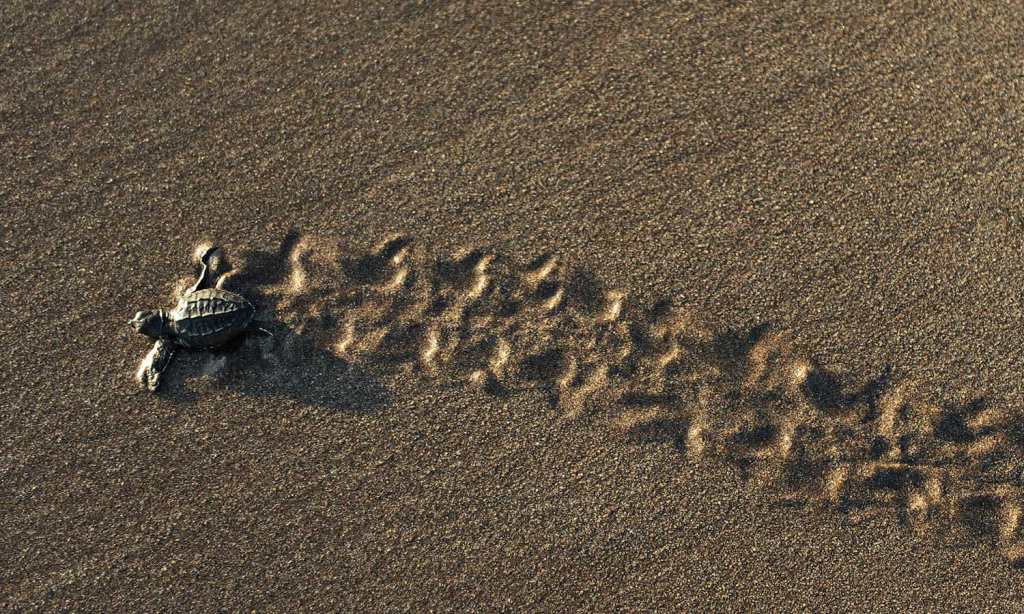With much of the world staying inside in an effort to stop the spread of coronavirus, the earth is experiencing some rather unexpected changes to its environment.
From improved air quality to less movement in the earth’s crust, these are some of the most notable environmental effects from COVID-19.
Baby Sea Turtles Flourish with Empty Beaches
Every nesting season, sea turtles face a plethora of obstacles that have been known to reduce their success of surviving. Crowded beaches and polluted waters are just the beginning, and these factors and more have impacted on the species’ ability to breed and survive the journey from nest to shore.
Now though, with beaches empty of people due to shelter-in-place restrictions, it would seem sea turtles are finally being given a fighting chance. The Guardian reports that a beach in Thailand has seen 11 new leatherback sea turtle nests since November, the largest number of nests found there in the last 20 years, and increasing numbers of nests have been recorded in other parts of the world, too. On Juno Beach in Florida, researchers at the Loggerhead MarineLife Center have already found and counted 76 sea turtle nests — a significant increase from the year prior.
“This is a very good sign for us because many areas for spawning have been destroyed by humans,” Kongkiat Kittiwatanawong, director of the Phuket Marine Biological Centre, told the publication.
Leatherbacks are the largest of all living turtles. Globally, leatherback turtles are listed as a vulnerable species, but many subpopulations are critically endangered, according to WWF.
Kangaroo Spotted Bounding Through Adelaide CBD
Protective Security Officers tracked a suspect wearing a grey fur coat hopping through the heart of the #adelaide CBD this morning. He was last seen on foot heading into the West Parklands 🦘🚔👮#animaltakeover #whatsthatskip #kangaroo #cityslicker pic.twitter.com/JPyVXIYQRw
— South Australia Police (@SAPoliceNews) April 19, 2020
Yosemite National Park Teeming with Wildlife Due to Lack of Tourists
Yosemite National Park in California was closed on March 20 to prevent the spread of COVID-19 and stop the virus from reaching the small communities who reside and work there.
While in 2019, the park in April hosted some 300,000 visitors, right now less than 200 service employees and those who reside in the towns are left to caretake and wander the park.
As a result, it would seem the wildlife within, including bears, bobcats and coyotes have begun to explore areas previously saturated with tourists. In a Facebook Live event recently, long-time park ranger and wildlife biologist, Katie Patrick, said: “bears are just literally walking down the road to get to where they need to go.
“For the most part, I think they’re having a party.”
Yosemite National Park is home to about 300-500 black bears. Though there hasn't been an increase in their population since the park closure, bears have been seen more frequently than usual. Check out this bear caught on camera yesterday, climbing a tree next to ranger housing! pic.twitter.com/9rXxIOMRbR
— Yosemite National Park (@YosemiteNPS) April 14, 2020
The Himalayas Visible for the First Time in 30 Years
The Himalayas can be seen from parts of India for the first time in three decades, as locals in the Jalandhar district in Punjab, some 200km away, have begun to notice.
As air pollution levels drop as a result of a 21-day lockdown around the country, residents to the area are posting their amazement for the snow-capped mountains, usually shrouded by air pollution, to social media. Many are seeing the mountains for the very first time.
India’s Central Pollution Board says the lockdown has resulted in a significant and positive improvement to air quality around the country. A recent report found a 33% improvement to air quality from March 16-27.
Never seen Dhauladar range from my home rooftop in Jalandhar..never could imagine that’s possible..clear indication of the impact the pollution has done by us to Mother Earth 🌍.. this is the view pic.twitter.com/laRzP8QsZ9
— Harbhajan Turbanator (@harbhajan_singh) April 3, 2020
Earth’s Crust Moving Less — Scientists Better Detect Earthquakes
Since we’re staying put, and ultimately, staying still, the earth’s crust is actually moving less, scientists at the Royal Observatory of Belgium have found.
A team of researchers at the facility have noted a significant drop in seismic noise — defined as a hum of vibrations in the earth’s crust — due to a lack in usual human activity like road transport and industrial machinery operations.
And with less ‘noise’ like these, scientists are finding they’re able to better detect ground motions like earthquakes, volcanic activity and explosions. Prior to the COVID-19 pandemic, it was much harder for scientists to distinguish between patterns.
According to data collected, vibrations as a result of human activity in Brussels has fallen by around one-third since mid-March, when the government introduced lockdown measures.
These results are bring reflected around the world, as seen by the Tweet below showcasing data from New Zealand.
The first day of living under #COVID19 Level 4 #HeavyManners is reflected in much reduced man made seismic noise in Auckland, New Zealand.
This is from @Geonet's Herne Bay seismometer.#eqnz pic.twitter.com/v1IzbE2xI7— ******* Pax (@matarikipax) March 26, 2020
Venice Canals Are Crystal Clear and Brimming with Fish
The ever-evolving COVID-19 pandemic continues, with Italy one of the most-affected countries in the world. At the time of writing, there are more than 159,516 cases and sadly over 20,465 deaths, according to Worldometer.
As such, the country is in strict lockdown, with more than 60 million people living inside their own homes while the healthcare system tries to cope with its current cases (and prevent cases further).
With people indoors, some drastic, and silver-lining-esque changes have already become visible. With an absence of boat traffic on Venice’s waterways, the canals have become crystal clear. Schools of fish have returned in an unexpected benefit the city has been pleasantly surprised to witness from the confines of their balconies.
And scientists say the world can learn a lot from these tangible changes.
“If we can think about how to prepare for climate change like a pandemic, maybe there will be a positive outcome to all of this,” Christopher Jones, lead developer of the CoolClimate Network, an applied research consortium at the University of California, Berkeley, tells NBC News.
“We can help prevent crises in the future if we are prepared. I think there are some big-picture lessons here that could be very useful.”
I canali di Venezia senza traffico di barche!!
Il risultato? Acqua limpidissima
Ph. Venice pictures pic.twitter.com/KGsKWNd56u— Albert Folaz (@FolinAlberto) March 11, 2020
Air Pollution Sees Significant Drops Worldwide
The global outbreak has contributed to a significant drop in pollution and greenhouse gas emissions, with the effects notably seen in countries like Italy and the outbreak origin of mainland China.
This week, satellite imagery from The European Space Agency (ESA) showed a noticeable drop in emissions of nitrogen dioxide, which is a noxious gas emitted by power plants, cars and factories.
From the start of the year until this week, the lift in emissions can be viewed in the timelapse below.
In China, and over a four week period, experts recorded a carbon dioxide emissions drop of one quarter or an estimated 200 million tons, The Independent reports. This is around half the amount of CO2 Britain emits in one year.
One new study from Stanford University scientist even suggests the coronavirus lockdown in China likely saved around 77,000 lives due to a reduction in pollution from factories and vehicles.
Marshall Burke, an earth systems professor at the university, used data from US government sensors in four Chinese cities to measure levels of PM2.5, which is a tiny particulate that’s considered the primary cause of death from air pollution.
Analysing the drop in pollution levels, he made informed calculations to the effects on mortality in China, as reported by Forbes.
Burke says that two months at the reduced rate of pollution “likely has saved the lives of 4,000 kids under 5 and 73,000 adults over 70 in China.”
He concluded his findings on G-Feed, which is blog contributed to by seven scientists working on Global Food, Environment and Economic Dynamics.
Nitrogen dioxide over #China has dropped with the coronavirus quarantine, Chinese New Year, and a related economic slowdown. https://t.co/URfLNy0GZJ #NASA #COVID2019 pic.twitter.com/PM60uL772K
— NASA Earth (@NASAEarth) March 4, 2020
The Australian Government Department of Health recommends the following steps to help prevent the spread of coronavirus:
- Wash your hands frequently with soap and water, before and after eating, and after going to the toilet
- Cover your cough and sneeze, dispose of tissues, and use alcohol-based hand sanitiser
- If unwell, avoid contact with others (touching, kissing, hugging, and other intimate
contact.)
The current health crisis is evolving rapidly. If you suspect you or a family member has coronavirus you should call (not visit) your GP or ring the national Coronavirus Health Information Hotline on 1800 020 080.







